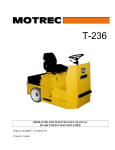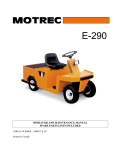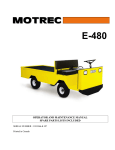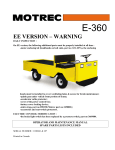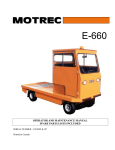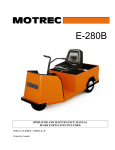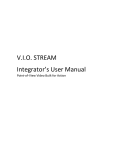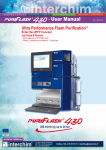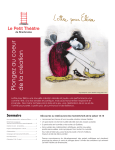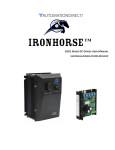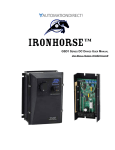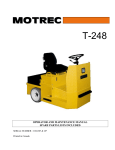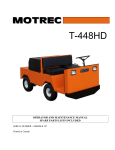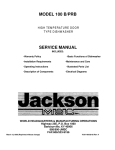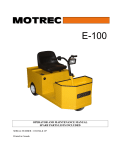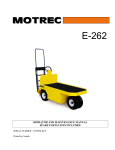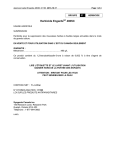Download e-480sc a modifier
Transcript
E-480SC OPERATOR AND MAINTENANCE MANUAL SPARE PARTS LISTS INCLUDED SERIAL NUMBER : 1038854 & UP Printed in Canada One Year Limited Warranty Effective April 25, 2005, MOTREC, Inc. (MOTREC) hereby warrants to the Original Retail Purchaser (Owner) that any of its vehicles shall be free from any defect in materials for a period of 90 DAYS while in the possession of such Original Retail Purchaser. This warranty IS NOT TRANSFERABLE to any subsequent Buyer. The warranty period is extended to one year or one thousand (1,000) hours, which ever first occurs, on the electric motor, differential (parts that bathe in oil) and the electronic speed controller. MOTREC makes no warranty or representation with respect to the internal combustion engine, tires and batteries, since their respective manufacturers cover such parts. Accessories (light, gage, horn, etc), electrical contacts (switch, solenoid, contactor, relay), diodes & fuses, belts & pulleys, filters & spark plugs, lubricants, brake linings & shoes, brake drums & discs, seals, seats, trim and other items subject to wear are not included in this warranty; nor is any item that in MOTREC sole opinion, shows evidence of neglect, misuse, abuse, collision or alteration. This warranty shall not apply to normal maintenance requirements as described in the User Manual, and to damages during shipment. The latter is the carrier's responsibility. No compensation will be allowed for delays. To initiate warranty coverage on any MOTREC vehicle, the Dealer must complete and return the “Sales/Installation Report” to MOTREC within 30 days after delivery to the Original Retail Purchaser; or within 90 days after the delivery date to the Dealer, which ever occurs first. Failure to follow these procedures will result in considering the warranty coverage effective as of the shipment date from the factory. The defective vehicle must be returned, at the Owner's expense, to an authorised MOTREC Dealer within 30 days after failure. The Owner will not be charged for parts and labour required for warranty repairs, which must be performed by an authorised MOTREC Dealer only. The vehicle will be returned at the owner’s expense. The Warranty Claim Forms must be completed and returned with the defective part(s) to MOTREC within 30 days after repair was done. No compensation will be allowed for damages caused by vehicle downtime. It is the responsibility of the owner of the vehicle to make sure that the driver is properly trained and instructed in the safety features and operation of the vehicle, including vehicle stability, as required by OSHA and ANSI-B56. Operators shall read, understand and follow the safety and operating instructions in MOTREC Manual before driving the vehicle. Operators shall not be permitted to drive the vehicle unless a complete and adequate training has been provided. Driving a vehicle constitutes a hazard. The driver is responsible for the control of the vehicle while driving and must always evaluate and care for all peculiar situations that he or she may meet while driving. The driver assumes the inherent hazards related to this activity. The vehicle is designed for off-road use only. MOTREC disclaims any liability for incidental or consequential damages, to include, but not be limited to, personal injury or property damage arising from vehicle misuse, lack of maintenance or any defect in the vehicle. It is the responsibility of the Owner of the vehicle to make sure that the service technicians are properly trained as required by OSHA and ANSI-B56. Service technicians shall read, understand and follow instructions in the MOTREC manual before servicing the vehicle. Only qualified and authorized personnel shall be permitted to maintain, repair, adjust and inspect the vehicle. MOTREC prohibits, and disclaims responsibility for, any vehicle modification altering the weight distribution and stability, increasing the speed or affecting the safety of the vehicle. Such modifications can cause serious personal injury or property damage for which MOTREC disclaims any responsibility. For Owners that are located outside North America, the warranty period starts the date of shipment from the factory, and the defective parts must be returned at the Owner's expense to MOTREC prior to warranty repair. 20/04/2006 Table of contents IMPORTANT…...IMPORTANT…...IMPORTANT……IMPORTANT Real and follow safety and operating instructions TABLE OF CONTENTS SAFETY SAFETY WARNINGS FOR OPERATORS USE OF NOTES, CAUTIONS AND WARNINGS GENERAL OPERATING RULES, SAFETY AND LIMITATIONS PERSONNEL QUALIFICATIONS SAFETY FEATURES MAINTENACE LOCK INTRODUCTION DESCRIPTION SPECIFICTIONS OPERATION PRELIMINARY INSTALLATIONS SCISSOR LIFT OPERATION PROCEDURE TO MOVE VEHICLE HYDRAULIC OIL FILL-UP PROCEDURE OPERATING INSTRUCTIONS MAINTENANCE SAFETY WARNINGS FOR SERVICE TECHNICIANS DECALS AND LABELS PERIODIC MAINTENANCE CHECKLIST SCISSOR PERIODIC MAINTENANCE CHECKLIST SCISSOR LIFT INSPECTION AND LUBRICATION WEEKLY LOG INSPECTION AND LUBRICATION ACCELERATOR BELT INSTALLATION AND TENSIONING HYDRAULIC BRAKES FRONT AXLE AND STEERING BATTERY MAINTENANCE BATTERY CHARGER ELECTRICAL TROUBLESHOOTING SCISSOR TROUBLESHOOTING HYDRAULIC SYSTEM CURTIS PMC MOTOR CONTROLLER OVERVIEW WIRING : STANDARD CONFIGURATION MAINTENANCE AND ADJUSTMENT SPARE PARTS BODY -3- 5 6 7 7 8 8 9 10 11 12 13 14 15 16 16 17 19 20 22 28 29 30 31 32 33 34 35 36 38 39 42 45 48 50 52 55 58 59 Table of contents DOWN VALVE ASSEMBY CAB FORD F-150 DIFFERENTIAL BRAKE CONTROLS FRONT ASSEMBLY MOTOR AND DRIVE REAR SUSPENSION AND BRAKE ELECTRICAL DIAGRAM – SERIES MAIN CIRCUIT ELECTRICAL DIAGRAM – CHARGER AND BATTERY ACCESSORIES – NO DC/DC CONVERTER ACCESSORIES – DC-DC CONVERTER OPTIONS SCISSOR LIFT - ELECTRICAL CIRCUIT BATTERY CONFIGURATIONS - 48V BUILT-IN / PORTABLE 25A CHARGER MOTREC ILLUSTRATED ACCESSORIES BATTERY DISCHARGE INDICATOR (HOBBS) ADDENDUM CURTIS FOOT PEDAL -4- 61 63 64 67 68 70 71 72 73 74 75 76 77 79 82 83 85 86 87 Safety SAFETY -5- Safety SAFETY WARNINGS FOR OPERATORS • FAILURE TO OBEY THE FOLLOWING SAFETY RULES MAIN RESULT IN SEVERE INJURY. • It is the responsibility of the owner of this vehicle to train operators to ensure that they understand the operating characteristics of this vehicle, including training in vehicle stability, and obey the following safety rules and guidelines. Owner shall comply with OSHA and ASME/ANSI B56.8 & B56.9 regulations for vehicle use, safety rules, operator training and certification. Do not drive this vehicle unless you are a qualified operator. • Do not drive this vehicle under the influence of drugs or alcohol. • Do not drive this vehicle on public roads and highways. This vehicle is designed to be driven in buildings. • The electrical system of this vehicle will make sparks which can ignite inflammable materials. Never use the vehicle in hazardous areas where there are inflammable materials, explosive dust or fumes in the air. • Have your vehicle inspected regularly by trained personnel, and cease operation if a malfunction occurs. • Do not open battery compartment to prevent battery explosion, acid splashing, severe damage to eyes or skin. • Do not open motor compartment. Keep clear from moving, rotating(wheels, sheaves, etc) or lifting parts. • Never carry more passengers than number allowed for this vehicle. Wait until all occupants are seated and holding on before moving. Always keep all body parts inside vehicle. Keep both hands on steering wheel. • Do not exceed the vehicle cargo load capacity and gross trailing weight capacity, rated for flat hard even surface. Different operating conditions such as loose terrain or ramps reduce vehicle capacity. • Avoid loose, unbalanced or top-heavy loads to keep a good stability and prevent overturn. Do not load cargo that can fall off the vehicle. Do not carry cargo that is longer, wider or higher than this vehicle. • Always depress slowly the accelerator for smooth acceleration. Avoid stunt driving or horseplay. • Avoid sharp turns, always slow down before turning, to prevent vehicle overturn or trailer jack knife. Vehicle is more sensitive to overturn and jack knife when traveling on inclines or when carrying a heavy load. • Always drive straight up and down the face of an incline, never across the face, to prevent overturn and trailer jack knife. Drive slower and start applying brakes sooner on inclines to adjust for longer stopping distance. • Use extra care and drive slowly in reverse, in congested areas or on wet or slippery ground. • Keep to the right under normal conditions. Maintain a safe distance from all objects. • Slow down and sound the horn when approaching a corner or other blind intersections. • Before leaving the vehicle, park on a level ground flat surface, turn off all switches, set the forward/reverse switch to neutral, set the parking brake, remove the key. Do not park the vehicle on an incline. • Before battery charging, park the vehicle in a well ventilated area set for. Do not operate it when charging. To interrupt a charging cycle, disconnect the AC plug; disconnecting the DC plug or a battery terminal, or operating the vehicle, could damage the charger and produce a spark, battery explosion and acid splashing. • Use another driver to steer this vehicle while it is towed. Be sure the driver uses brakes when you slow or stop the towing vehicle. Do not exceed 5 MPH or carry any passenger while towing this vehicle. -6- Safety USE OF NOTES, CAUTIONS AND WARNINGS NOTE – additional information to further explain instructions. CAUTION – Failure to follow instruction could cause damage to equipment. WARNING – Failure to follow instruction could cause death, personal injury and property damage. DANGER – Failure to follow instruction will cause death, personal injury and property damage. GENERAL OPERATING RULES, SAFETY AND LIMITATIONS • • • • • • • • • Inspect machine before using. Do not use machine if it is not working properly in any way. Check job site for unsafe working conditions. Do not operate on uneven or soft terrain. Do not raise platform if machine is on an incline. Never carry people and/or cargo on platform while moving. Use machine only for purposes for which it was designed. Do not raise platform if stabilizers are not fully extended and lock. Do not exceed the load capacity of platform (1000 lbs) and the load capacity of extended deck (500 lbs) An operator of any type of work platform is subject to certain hazards that cannot be protected by mechanical means. It is therefore essential that operators be competent, careful, physically and mentally fit and thoroughly trained in safe operation of this machine. -7- Safety PERSONNEL QUALIFICATIONS * Operation of E-480SC shall be restricted to certified personnel as required by OSHA. * Maintenance of E-480SC shall be restricted to qualified trained personnel as required by OSHA. * Before operation or maintenance, personnel shall read and thoroughly understand this manual. If a proposed operator or maintenance man fails to understand any segment of this manual, his Supervisor can clarify the misunderstanding through written correspondence or phone call to: MOTREC inc, 200 Indusrial Boul. South, Bromptonville (Quebec) Canada, J0B 1H0 Phone: (819) 846-2010 ext: 226 Fax: (819) 846-3050 E-mail: [email protected] Web site: www.motrec.com SAFETY FEATURES 1. Platform won’t move up if stabilizers are not fully extended. Stabilizers won’t disengage if platform is not fully down. Vehicle won’t travel if stabilizers are not fully retracted. 2. Emergency Stop: The emergency stop is located on the control console. Depress red knob as indicated and all functions of machine will be de-energized. Pull the knob to reactivate circuits (Figure 1). 3. Emergency Down The emergency down control is located on the left side. Pull handle to allow platform to descend back to the stowed position (Figure 2). Figure 1. Control Console Emergency Stop Figure 2. Emergency Down Handle -8- Safety MAINTENACE LOCK 1. Remove load from platform. 2. Raise platform as high necessary to engage maintenance lock. 3. Maintenance lock is located at the rear of the unit between the inside beam assemblies. With machine raised part way, lift maintenance locks and lower machine so that pivot pins are resting on maintenance lock (Figure 3). Figure 3. Positioning Maintenance Lock -9- Introduction INTRODUCTION - 10 - Introduction DESCRIPTION Motrec E-480SC is electrically driven, hydraulically operated units. The platform is raised and lowered by a scissors mechanism. Motrec E-480SC platform is raised by a hydraulic cylinder, which is controlled from the control console on the platform. Emergency lowering and auxiliary lift controls located at the base of the machine. Figure 4. Motrec E-480SC - 11 - Introduction SPECIFICTIONS Through our constant efforts to improve our products, specifications may change without notice. E-480SC Mobile Lift The E-480SC is engineered for large industrial plants that require rapid response over long distance. The E-480SC is ideal for warehouse, airport and in-plant uses. The E-480SC is the only vehicle of its kind and includes: • • • • • • • • • • • • • • Descent alarm and flashing light. 48 volt drive controls and accessories. 24 volt hydraulic controls and a 4HP pump. Eight 6V/220AH deep cycle batteries. Roll-out battery tray. 48V/25A Lestronic II charger. Automotive differential. Curtis-PMC electronic speed control Curtis 802 battery discharge indicator. 48V headlight, tail/brake lights and horn. Hydraulic disc brakes on all four wheels. Front and rear leaf spring suspension. 5.70 x 8 L.R.D. tires 1000 lbs platform capacity (500 lbs extended platform capacity). The E-480SC carries two people up to 8 MPH for faster response to maintenance or emergency sites. It is fully self-contained and able to move over railroad crossings and rough terrain. This is due to its use of large tires and automotive leaf springs in the front and rear. Motrec even offers the availability of special boxes on the platform for airport and warehouse needs. - 12 - OPERATION OPERATION - 13 - OPERATION Description PRELIMINARY INSTALLATIONS 1. Remove all packing materials and inspect for possible damage during shipment. Report any damage immediately to the person delivering the equipment. 2. If side railings are not installed, install side railings on four sides of the platform. Pin front and rear rails to the sides with clevis pin provided. Check that platform extension slides freely, and gate swings freely. NOTE To install extending platform, refer to the extending platform illustration in this manual 3. Make sure carrying capacity and warning decals provided state correct capacity for your machine, and are installed to platform as illustrated. Figure 5. Platform Railings and Warning Decal. - 14 - OPERATION 4. 5. 6. 7. 8. If not assembled before shipment, connect cable to control console provided and install console on platform railing. Pull emergency stop button if it has been depressed (Figure 6). If wheels have not been installed, install them. Pull emergency stop button on lower control station if it has been depressed (Figure 6). Check oil level in hydraulic reservoir (see sight glass). See next page fill-up procedure. Inspect machine for hydraulic oil leaks. Do not use the machine until leaks are serviced. SCISSOR LIFT OPERATION PROCEDURE 9. 10. 11. Turn key switch at “lift” position. Fully extend stabilizers using toggle switch at “stab” position at lower control station. Make sure legs will stand on even surface. Move up platform using toggle switch at “up” position at lower control station or using toggle switch “up” position* (upper control station). To stop platform movement, release the toggle. *If you have 2-speed option: Lower station default is “up fast” while upper station default is “upslow”, Simply press “upslow” switch and “fast” button at the same time to get “upfast” function. Figure 6. Controls 12. 13. MAKE SURE MAINTENANCE LOCK IS SECURELY POSITIONED ON ITS SUPPORT AND WON’T DISTURB BEAN MOVEMENT. Use toggle switch at “down” position to move platform downward (any station). To stop platform movement, release the toggle. - 15 - OPERATION TO MOVE VEHICLE 14. To unlock stabilizers, activate stab switch and pull unlock lever. Keep pulling lever while activating unstab switch to retract stabilizers. Figure 7. Unlock main lever 15. When stabilizers are fully retracted, sit down, turn key switch at F/R position to move vehicle, set F/R switch for direction. NOTE: Stabilizers must be fully extended to operate the platform; or fully retract to move vehicle forward/reverse. If the platform is partly raised, stabilizers cannot be activated. HYDRAULIC OIL FILL-UP PROCEDURE • Lower platform so that maintenance lock is resting on pivot pin. • • • Remove filler cap and check fluid reservoir. Fill to proper level using AWE32 hydraulic oil. Replace filler cap. Raise platform slightly and retract maintenance lock. Inspect hydraulic system for leaks. Check oil leakage at leg bottom hole. - 16 - OPERATION OPERATING INSTRUCTIONS It is the responsibility of the owner of this vehicle to ensure that the operator understands the operating characteristics of this vehicle, and obeys the safety instructions (ANSI B56). Do not drive this vehicle unless you are a qualified operator. BEFORE USING VEHICLE Before turning on key switch: set to neutral, check for any visible damage, check brake pedal. BATTERIES Never open the battery compartment unless you have received proper training for battery maintenance. Batteries emit explosive hydrogen gas that can be ignited by a spark or loose terminal. Battery acid causes severe damage to eyes or skin. Flush the contaminated area immediately with water. BATTERY CHARGER Park the vehicle in a well ventilated area for battery charging. Most battery chargers come with an electronic control that starts when the charger is plugged and stop when the battery is fully charged. To interrupt the charging cycle, disconnect the AC-plug, do not disconnect the DC plug. BATTERY DISCHARGE INDICATOR The green light moves from right to left as batteries are being discharged. When the green light is at the last position on the left the batteries must be recharged. A flashing light warns the operator that further discharge will damage batteries. See HOBBS indicator instructions KEYSWITCH/LIGHTS Three positions with off at center. Depress brake pedal and turn the key switch clockwise for F/R position and turn headlight on. Turn key switch clockwise to operate the platform. Always turn off all switches, set the F/R selector to neutral, set the parking brake, and remove the key before leaving the vehicle. HORN Depress the horn button on the steering column or handle bar. F/R SWITCH Three positions with neutral at center. Depress the front part of the rocker switch for forward direction. Depress the rear part of the rocker switch for reverse direction. Always set switch to neutral, turn off all switches, set the parking brake, and remove the key before leaving the vehicle. ACCELERATOR PEDAL It is designed for right foot operation only, and controls the speed of the vehicle. FOOT BRAKE PEDAL It is designed for right foot operation only. The brake force is proportional to the pressure on the pedal. PARKING BRAKE Pull handbrake lever to apply. Never park the vehicle on an incline. Always turn off all switches, set the F/R selector to neutral, set the parking brake, and remove the key before leaving the vehicle. - 17 - OPERATION CONTROLS IDENTIFICATION – PLATFORM EMERGENCY PUSH BUTTON SWITCH Pull the emergency stop button on the lower control station to turn ON platform. This switch cuts all power to the platform when it is pushed. Pull the emergency stop button on the upper control box for UP/DOWN operation. STABILIZERS The stabilizer control switch is located on lower control station. FOLD DOWN GUARDS Before lifting the platform, raise the guards and lock with pins at each corner. EXTENDING PLATFORM Remove the lock pin, push the platform forward and lock with pin. (Figure 8) Figure 8. Extended platform UP/DOWN Stabilizers must be fully extended. UP/DOWN switches are located on the upper control box and the lower control station. Manual down control handle is located on the left side. - 18 - Maintenance MAINTENANCE - 19 - Maintenance SAFETY WARNINGS FOR SERVICE TECHNICIANS FAILURE TO OBEY THE FOLLOWING SAFETY RULES MAIN RESULT IN SEVERE INJURY. Owner shall comply with OSHA and ASME/ANSI B56.8 & B56.9 regulations for vehicle maintenance. Only qualified and authorized personnel shall be permitted to maintain, repair, adjust and inspect carriers, vehicles, tractors, and batteries. Before any maintenance work, park the vehicle on flat level surface, turn off all switches, remove key, lift wheels off the ground and secure with jack stands of adequate capacity. Don’t connect charger. Keep clear from moving parts such as tires, sheaves and motor. Follow the maintenance instructions applicable to the type of repair, maintenance, or service. Always wear a face shield and gloves when working around batteries. Before opening the battery compartment, disconnect the charger, turn off all switches and remove the key. Batteries emit highly explosive gases which greatly increase when charging; do not disturb connections or produce sparks around batteries to avoid a battery explosion and acid splashing. Battery acid causes severe damage to eyes or skin. Flush contaminated area immediately with water. Use insulated tools to avoid sparks that can cause battery explosion and acid splashing. Use two counteracting tools, double-wrench technique, when disconnecting or tightening terminals on the battery and the speed controller to avoid cracking the terminal or battery post welds. Before cleaning or replacing a battery, charger, speed controller, contactor, relay, diode, or any other component in the power circuit, always disconnect the charger, turn off all switches, remove the key, wear a face shield and gloves, identify battery polarity and disconnect battery leads, discharge the capacitor in the controller with a 10 ohms, 25 W resistor for a few seconds across B+ and B-. After cleaning, the power must not be reapplied until terminal areas are thoroughly dry. On EE-Rated vehicles make sure that the control box is sealed, the static strap makes good contact with the ground, the motor is sealed by bands, the cable protectors are properly installed. Keep cables and wires clear from mechanical and rubbing action. Make sure that cable insulation is free from cutting or visible damage. Make sure that EE-Rated cable protectors are properly installed. Before replacing a fuse or circuit breaker, identify the cause of failure and repair. Programmable controllers must be programmed using the parameter settings in this service manual, before connecting the motor, to avoid sudden vehicle movement and accident. - 20 - Maintenance Do not try to increase motor speed by changing parameter settings in the speed controller; it can cause accident and severe damage to the motor. SEPEX speed controls are protected by a diode in the power circuit to filter inductive loads in the event of a sudden power interrupt. Some speed controllers require a diode to filter inductive loads on the KSI input. Removing the diodes will cause the speed control failure. Before resuming maintenance operations, inspect safety warnings stickers and replace any if damage is found and part of the text can’t be read. - 21 - Maintenance DECALS AND LABELS ! CAUTION ! The images included in this section depict the decals/markings installed on the vehicle. It is of the utmost importance that theses decals/markings remain unaltered and readable. Else, the sticker or the part baring the marking has to be replaced. Dashboard security warning label: #5100000002 General security warning label: #5100000001 #4800012O #4800012D - 22 - Maintenance Respectively, forward/reverse selector and light switch marking: Key switch marking: LIFT F/R #4800012S Scissor security warning labels (located on both side): KEEP CLEAR #4800012L Striped marking tape 4” #4800012W Stabilizers security warning label (Each faces, sides and rear): Striped marking tape 3” # 30102 - 23 - Maintenance Platform capacity warning labels (located on both side): 1000 LBS MAX. CAP. #4800012M Striped marking tape 4” #4800012W Extending Platform capacity and security warning labels (located on rear end): 500 LBS MAX. CAP. #4800012N #4800012X - 24 - Maintenance Security warning label on platform control box: #4800012E (located on the top of box) UP DOWN STOP FAST #4800012Q #4800012U #4800012Z (Optional 2 speed up) Maintenance Lock security warning label (Located at the rear end): #4800012G Lower control station labels: STAB UNSTAB UP DOWN #4800012R #4800012T - 25 - Maintenance Battery security warning labels: #4800012H (Located on battery connector side). 4800012K (Located on top of battery tray, connector side). #4800012J (Located near the battery connector). - 26 - Maintenance Lower Railings security warming labels: #4800012F (Located on left side, be on lower control station). #4800012A (Located on left side, beside emergency down handle). UNLOCK #4800012V (Located on left side, beside unlock main lever). #4800012P (Located on right side, in middle). - 27 - Maintenance PERIODIC MAINTENANCE CHECKLIST ! WARNING ! Maintenance operations must be made by properly trained service technicians. − Keep clear from moving parts such as tires, sheaves and motor. − Check for all EE protections, when applicable, and keep cables and wires clear from mechanical and rubbing action − Batteries contain sulphur acid that can cause severe burns on skin or eyes. − When working around batteries, wear acid proof protective equipment: face shield and gloves. − Use electrically insulated tools to avoid sparks that can cause battery explosion. − Before any maintenance work, park the vehicle on a flat level surface, turn off all switches, remove the key, lift the wheels off the ground and secure with jack stands of adequate capacity, identify and disconnect battery leads. Don’t connect the charger. PERIOD DAY CHECK/PERFORM HOURS MECHANICAL DAMAGE, OIL LEAKS X REVERSE ALARM, DEADMAN SWITCH X STATIC STRAP, min 2” contact with ground X TIRE PRESSURE, pressure rating on tire CHECK/FILL BATTERIES, add distilled water to cover plates. Fill to recommended level after batteries have been fully charged. WARNING DECALS & MARKINGS EE-Rated CABLE PROTECTORS, SEALED MOTOR, SEALED CONTROL BOX. MASTER CYLINDER FLUID (DOT 3) BRAKE PEDAL TRAVEL 2” (50 mm) maximum travel STEERING FOR PLAY PARKING BRAKE LEVER requires 10 lbs. (5 kg) force to apply BELTS AND PULLEYS -10 lbs (5kg). force for 1/8” (3mm) deflexion; -pulleys alignment, see procedure. CLEAN/TIGHTEN WIRE TERMINALS WASH BATTERY TOP WITH WATER MOTOR BRUSHES FOR WEAR -brushes must exceed holders ACCELERATOR ADJUSTMENT -1/8” (3 mm) travel to activate micro-switch; -0 to 50 ohms when micro-switch activated; -4500 to 5500 ohms with pedal down. HYDR. BRAKE LINES FOR LEAK STEERING ASSEMBLY, as instructed BRAKE MECHANICAL LINKAGES for wear & play BRAKE LININGS FOR WEAR 1/16” (1.5 mm) minimum lining thickness. LUBRICATE brake pedal pivots, steering column, ball joints and kingpins. OIL (SAE 30) LEVEL IN DIFFERENTIAL Before adding oil, check oil seals for leaks. FRONT WHEEL BEARINGS PLAY TIGHTEN NUTS/BOLTS, electric terminals; drive; steering; brakes; suspension; body. WEEK 20 MONTH 50 QUART. 200 YEAR 1000 2 YEARS 2000 X X X X X X X X X X X X X X X X X X X X X REPLACE DIFFERENTIAL OIL(SAE 30) CLEAN AND RE-PACK FRONT HUBS SERVICE DIFFERENTIAL, replace the three oil seals, wheel bearings, oil (SAE 30) X X X - 28 - Maintenance SCISSOR PERIODIC MAINTENANCE CHECKLIST PERIOD HOURS CHECK MECHANICAL DAMAGE -STABILIZERS -SCISSOR WELDMENTS -SCISSOR PIVOTS & SNAP RINGS -PLATFORM GUARDS -EXTENDING DECK DAY WEEK 20 MONTH QUART. 50 100 YEAR 1000 X ELECTRIC DAMAGE -CABLE THROUGH SCISSOR -CABLE TO UPPER BOX -CABLE ON LIFTING CYLINDER -UPPER CONTROL BOX -LOWER CONTROL STATION -STABILIZER LIMIT SWITCHES X HYDRAULICS SYSTEM -CYLINDER AND DOWN VALVE BODY FOR LEAKS -FLUID LEVEL, AWE 32 -OIL FILTER PRESSURE GAUGE -OIL FILTER REPLACEMENT X SAFETY DECALS -CHECK IF MISSING -CHECK IF LEGIBLE X X LUBRICATE -SCISSOR -2 CYLINDER PINS X PUMP MOTOR BRUSHES FOR WEAR -BRUSHES MUST EXCEED HOLDERS -BLOW OUT CARBON DUST X CHECK / TIGHTEN X -HYDRAULIC FITTINGS -NUTS / BOLTS** -TERMINALS -SCISSOR PIVOTS & SNAP RINGS -CYLINDER PINS -GUARDS TABLE 10. SCISSOR LIFT INSPECTION AND LUBRICATION SCHEDULE - 29 - Maintenance SCISSOR LIFT INSPECTION AND LUBRICATION WEEKLY LOG Check and Initial Every 15 Hours of USE or Weekly COMPONENT MONTH DAY INITIAL BATTERY 1. Clean Battery 2. Coat Terminals HYDRAULIC SYSTEM 1. Check Fluid Level AWE32 2. Inspect Commutator and Brushes * Date Last Checked ________________________________ 3. Check Fittings SCISSOR SYSTEM 1. Check for Damage DRIVE AND LIFT MECHANISMS 1. Oil Steering Pivot Points 2. Oil Brake Pivot Points 3. Check All Fasteners MAIN FRAME 1. Check Structure CONTROL SYSTEM 1. Chack Terminals and Plugs 2. Check Cords *Check every 6 months TABLE 11. SCISSOR LIFT INSPECTION AND LUBRICATION WEEKL LOG. - 30 - Maintenance INSPECTION AND LUBRICATION Structure Inspection 1Check machine for bent structural members. (Beams, main frame, platform, pivot pins, etc.). Machines which have been overloaded could have bent members and fatigued pivot pins. Replace all bent members and pins to insure a safe operation machine. 2Check bushings in scissor beams for or cracked welds. Replace beams if bushing welds are cracked or bushings elongated. Lubrication 1The MOTREC E-480SC scissor lift contains several pivot pins or rollers that require lubrication (Figure 9). 2Steering rod linkage pivot and joint also require lubrication. Figure 9. Lubricate pivots. - 31 - Maintenance ACCELERATOR GEAR − Remove the cover. − Backlash between gears must be reduced to a minimum by sliding holder; use locktite 262 to lock the three screws. − When the plastic gear is fully depressed a small backlash must remain between the gears. − When the plastic gear is released its rear portion must not exceed the pedal case. MICRO-SWITCH The micro-switch must deactivate the on/off solenoid when the accelerator is released; turn the adjusting screw (shown on figure below) to adjust the micro-switch height. POT − Remove the terminals 2 and 3 on PMC to measure resistance signal. − When the micro-switch is activated the signal must be less than 50 ohms. When the front portion of the pedal is fully depressed the signal must be more than 4600 ohms. − To modify the resistance, turn the adjusting screw to change the micro-switch height (see figure below). Proceed with the same verifications after the accelerator cover is on and then connect terminals 2 and 3. - 32 - Maintenance BELT INSTALLATION AND TENSIONING INSTALLATION Adjust the sprockets using a straight edge. Slide up the edge on the larger pulley until it contacts the smaller pulley. Properly adjusted pulleys will provide three points of contact. Properly aligned pulleys will provide four points of contact. Tighten setscrews and recheck alignment. TENSIONING Check the force F required to provide a deflection of 1/8 in. If the measured force is less than 15 lbs then lengthen centre distance C. - 33 - Maintenance HYDRAULIC BRAKES DRUM BRAKES Remove brake drums and check linings wear; the linings should have a thickness exceeding 1/16" (1.5 mm). Turn the brake adjustment to reduce the clearance between lining and drum but avoid contact or drag when the wheels are turned and the pedal is released. DISC BRAKES Check pad linings for excessive wear; the linings should have a thickness exceeding 1/16" (1.5 mm). Disc brakes are self-adjusting. BRAKE PEDAL If the brake pedal becomes soft or spongy, air may have entered the hydraulic system and the brake system has to be bled: 1. fill the master cylinder with brake fluid (DOT-3); 2. bleed front callipers one at a time by having someone applying a steady pressure on the brake pedal, and close the bleeder before allowing the brake pedal to return to up position; 3. fill the master cylinder with brake fluid (DOT-3); 4. bleed rear wheel brakes one at a time, following the same procedure; 5. fill the master cylinder with brake fluid (DOT-3); 6. clean every fitting and line, remove traces of oil; 7. apply a continuous pressure on the brake pedal for about five minutes ; 8. Finally, inspect brake lines and fittings for leaks ; - 34 - Maintenance FRONT AXLE AND STEERING ! CAUTION ! Before maintenance, turn off all switches, set to neutral, set parking brake, remove the key, and raise the front end of the vehicle supporting it with two jack stands of adequate capacity STEERING INSPECTION − Check tire inflation pressure, suspension components, tie rods straightness, tie rod ends play (wear), play (wear) in wheel bearings, kingpins and bushings. REPLACING & ADJUSTING THE STEERING GEAR − Remove the pitman arm; − The steering box makes 6.5 turns, center the steering gear (3.25 turns from either side); − Align the front wheel straight. Install the pitman arm. TOE-IN ADJUSTEMENT − With the wheels in straight forward direction, measure the inside (left to right) distance between the front tires, at the front and rear of the tires; − Turn the rear tie rod until the distances are equal and tighten the two lock nuts on the tie rod. REMOVING & GREASING OF FRONT HUBS, required once-a-year − Remove dust cap and cutter pin, unscrew nut, remove hub; − Inspect bearings and races for wear and replace worn bearings; − Replace the seal; − Pack the hub with wheel bearing grease and re-assemble. ADJUSTING FRONT HUBS − Tighten spindle nut to 30 ft-lb to seat the bearing and back off the nut to the next slot; − Install a new cutter pin and the dust cap. - 35 - Maintenance BATTERY MAINTENANCE − − − − − − − − − − ! WARNING ! It is the responsibility of the owner of this vehicle to ensure that the service technicians are properly trained, read and obey the safety rules and guidelines in this manual (ANSI B56). Maintenance operations must be made by properly trained service technicians only. Before any maintenance work, park the vehicle on a flat level surface, turn off all the switches, set to neutral, remove the key, lift the wheels off the ground and secure with jack stands of adequate capacity. Keep charger disconnected while doing any maintenance work. Always wear a face shield and scarf when working around batteries. Battery emits highly explosive gases; do not produce sparks to avoid battery explosion and acid splashing. Battery acid causes severe damage to eyes or skin. Flush contaminated area immediately with water. Use insulated tools to avoid sparks that can cause battery explosion and acid splashing. Use two counteracting tools, double-wrench technique, when disconnecting or tightening battery posts. Before cleaning or replacing a battery, discharge the capacitor in the controller with a 10 ohms, 25 W resistor for a few seconds across B+ and B-, identify battery polarity and disconnect battery leads. After cleaning, the power must not be reapplied until terminal areas are thoroughly dry. BATTERY LEADS AND CONNECTORS Check for loose connections, damaged cables, acid spill, loose terminal posts, quarterly. BATTERY POST CORROSION If corrosion is present on battery posts, remove the cable connectors, use a wire brush to remove particles, and then clean them with a cloth that has been moistened with ammonia. ELECTROLYTE LEVEL Does not apply to sealed battery. − Disconnect battery connectors on roll-out or lift-out installations. − Make sure the battery roll-out tray is provided with stops before rolling out. − Fill with distilled water. − Daily charged batteries normally require watering once a week. Under watering leads to a shortened battery life. Over watering leads to battery corrosion. Be careful not to overfill any cell to avoid electrolyte to be forced out while charging. − Fill each cell to plate level with distillated or de-ionized water, before battery charging. When the battery is charged, the fluid expands and can seep out if overfilled. Refill each cell after full charge, when the fluid has expanded to its maximum level. − Reinstall battery caps before charging. - 36 - Maintenance BATTERY MOUNTING A loose battery increases damaging effects of vibrations and is more prone to short out. BATTERY DISCHARGE LIMIT Discharging below a 20% state of charge cuts down the battery life and the number of cycles available. At 20% state of charge, specific gravity of 6V battery should be 1180; and 1220 for industrial battery. CHARGING AREA − Always charge battery in a well ventilated area set for and approved for charging. − Never leave a charger connected for more than 20 hours. FREQUENCY OF CHARGE − When a battery is discharged to its 20% state of charge, it is best to charge immediately. − Batteries require a low current equalization charge (min 4 hours) at least every week, to equalize battery cells, improve battery performance and life in number of cycles. − Never leave a charger connected for more than 20 hours. STORAGE − Keep the battery from getting cold, it would loose its capacity. − Let the battery warm up before charging. − Charge batteries in “stored” vehicles every month. DEFECTIVE BATTERY Check specific gravity of each cell; if a cell is shorted, voltage drop may occur only when there is current. - 37 - Maintenance BATTERY CHARGER ! WARNING ! Always unplug the AC and DC electrical cords before attempting any repairs to the charger. CHARGER DOES NOT TURN ON: − Dc cord of portable chargers must be disconnected from batteries after every charge to restart; − Check dc fuse links; − Check battery voltage at the battery connector; − Check ac outlet and cordset; − Replace electronic control ; RELAY CLOSES AND TRANSFORMER HUMS BUT AMMETER DOES NOT REGISTER: − Check dc fuse links; − Check the continuity of the dc output cord, ammeter, diodes and all connections in the dc circuit; − Check diodes; − Check capacitor(rapidely increasing resistance); SINGLE CHARGER FUSE BLOWS: − Disconnect and check diodes; BOTH FUSE LINKS BLOW: − Check the battery pack and battery connector polarity; − Disconnect and check diodes. CHARGER OUTPUT IS LOW: − Disconnect and check diodes; − Can be caused by a transformer failure. AMMETER READS 30 AMPS FOR MORE THAN 30 MINUTES: − Check the battery pack; CHARGER DOES NOT TURN OFF: − Check specific gravity in each battery cell; − As much as 16 hours may be required to properly charge heavely discharged new or cold batteries; − Replace electronic control. AC LINE FUSE OR CIRCUIT BREAKER BLOWS: − Check ac cordset; − Check ac line fuse rating; − Replace electronic control; − Can be caused by a transformer failure. - 38 - Maintenance ELECTRICAL TROUBLESHOOTING ! WARNING ! Maintenance work must be performed by trained service technicians only. It is the responsibility of the owner of this vehicle to ensure that the services technicians are properly trained, understand and obey the safety rules and guidelines (ANSI B56). All service technicians must read and understand the maintenance warning section in this manual. ! WARNING ! Before any maintenance work, park the vehicle on a flat level surface, turn off all switches, remove the key, lift the wheels off the ground, secure with jack stands of adequate capacity, disconnect charger. Always wear safety glasses. Batteries emit highly explosive gases that can be ignited by a spark. Before disconnecting a high current terminal, turn off all switches, disconnect battery charger, disconnect batteries. Keep clear from moving parts such as tires, sheaves and motor. PMC SELF DIAGNOSTIC If your PMC comes with a status led, use the flashing code to help troubleshooting. BATTERY VOLTAGE Make sure batteries are securely connected. Measure voltage between + and - terminals. We will call this value B+ or full battery voltage. ACCESSORIES NOT WORKING − Check the fuses on the batteries and the DC/DC converter. − Check voltage across + and – terminals on the battery gage; if not B+, check wiring. − Turn the key switch ON, check voltage between output terminal on the key switch and the terminal on the battery gage; if not B+, replace the key switch. − Check voltage across DC/DC converter output terminals; if not 12-Volt, replace the converter. − Depress the accessory switch, check voltage across accessory terminals. If not 12-Volt, replace the switch. If 12-Volt, replace the accessory. FORWARD ONLY On a SEPEX motor control, check the reverse signal input on the controller. On a series wound motor control, a bad reverse contactor is the most probable cause of the problem. Switch to reverse and check voltage on the reverse control wire. If not B+, replace the F/R switch. If B+, turn off the key switch, disconnect batteries, disconnect power terminals on the F/R contactors, check the resistance across N.C. power terminals of the reverse contactor. If not 0 ohm, change the reverse contactor. If 0 ohms, switch to forward and check the resistance across the forward N.O. power terminals. If not 0 ohms, change the forward contactor. - 39 - Maintenance REVERSE ONLY On a SEPEX motor control, check the forward signal input on the controller. On a series wound motor control, a bad forward contactor is the most probable cause of the problem. Switch to forward and check the voltage on the forward control wire. If not B+, replace the F/R switch. If B+, turn off the key switch, disconnect batteries, disconnect power terminals on the F/R contactors, check the resistance across N.C. power terminals of the forward contactor. If not 0 ohm, change the forward contactor. If 0 ohms, switch to reverse and check the resistance across the reverse N.O. power terminals. If not 0 ohms, change the reverse contactor. TRAVEL AT REDUCED SPEED Check batteries. Turn off all switches and disconnect charger. Wear face shield and gloves. Do not disturb any battery connection to avoid sparks. Check the specific gravity of each cell. Cold batteries, highly discharged batteries or dead cells are the most frequent causes of reduced travel speed. Check potentiometer. Turn off the key switch, disconnect potentiometer terminals. Check the resistance between terminals. Other causes of lower speed: − dragging brakes; − cold temperature (higher differential oil viscosity). INTERMITTENT OPERATION A bad potentiometer is the most probable cause of the following: − acceleration is not constant; − maximum speed is erratic; − sudden stop after a bump or shock; − erratic starts, requiring several pedal cycles. A bad F/R contactor is also a probable cause of the following: − sudden stop after a bump or shock; − would not start to move at times. Erratic starts could also be the cause of a misadjusted potentiometer or micro-switch; the pot signal must be less than 50 ohms when the micro-switch turns on. PMC has an HPD safety feature that prevents the vehicle from moving if the accelerator pedal is depressed before the key switch is ON and seat switch is activated. PMC may also have an SRO safety feature that prevents the vehicle from moving if the F/R switch is activated before turning on the key switch and activating the seat switch. The vehicle stops on a steep and long ramp or while towing a heavy load: the circuit breaker has open to prevent motor overheating and will reset automatically after one minute. The PMC is also equipped with an internal thermal protection that cutback the current until the PMC has cooled down. - 40 - Maintenance NO MOTION Make sure that the PMC surface is clean and dry; check the terminal areas. Dust Particles or acid contamination, can create current leaks and cause a PMC malfunction. Check F/R switch Turn on the key switch and set to forward. Check voltage between the forward terminal and the – terminal on the battery gage, check voltage between the reverse terminal and the – terminal on the battery gage; if both B+, replace the F/R switch. Check switches and wiring Disconnect control terminals on the PMC and check all control signals. If a switch pin does not read B+, check wiring or replace the switch. Check potentiometer Turn the key switch to OFF, disconnect potentiometer terminals. Check the resistance across terminals: if not within the recommended limits, adjust or replace the potentiometer. Check for shorts between potentiometer wires and vehicle frame; resistance should read at least 1 megohm. Check main contactor or solenoid Check voltage across power terminals; if not B+, check circuit breaker or replace the solenoid. Turn to on the key switch and activate the seat switch. Check voltage across the coil terminals; if not B+, check wiring and interlock switches. Check resistance across power terminals; if not 0 ohms, replace the solenoid. Check circuit breaker and SEPEX DIODE Before replacing the circuit breaker, check for shorts in the power circuit and check the SEPEX diode in the power circuit using a diode tester. If no such instrument is at hand, use an ohmmeter: the reading should be weak in one direction and strong in the other way. Check the resistance across the circuit breaker. If not 0 ohms, replace the circuit breaker. Check PMC First disconnect battery B+ and B-, then PMC B+ and M-. Check the internal diode between B+ and M- terminals using a diode tester. If no such instrument is at hand, use an ohmmeter: the reading should be weak in one direction and strong in the other way. If the internal diode is defective, the PMC must be replaced. Check the Motor First disconnect battery B+ and B-, disconnect power terminals and check the motor armature and field for opens. - 41 - Maintenance SCISSOR TROUBLESHOOTING NO LIFT MOTION (pump not operating) POSSIBLE CAUSES 1. Blown fuses. 2. Dead battery. Battery contacts. 3. 4. 5. 6. 7. 8. 9. REPAIR PROCEDURES 1. Check fuse and replace if necessary. 2. -Check fuse and replace if necessary. -Check and charge battery as directed in maintenance section. -Check battery disconnects. 3. Refer to electrical schematic. 4. Replace brushes and springs. 5. Replace motor. 6. Replace contactor. 7. Replace switch or coil. 8. Replace KEY switch. 9. Replace UP switch. Electrical circuit defective. Worn brushes. Shorted armature. Defective motor contactor. Defective emergency stop switch or coil. Defective KEY switch. Defective UP switch. NO FAST LIFT (pump not operating) REPAIR PROCEDURE 1. Refer to electrical schematic. 2. Replace brushes and spring. 3. Replace contactor. 4. Replace pump relay coil or switch. POSSIBLE CAUSES 1. Electrical circuit defective. 2. Worn brushes. 3. Defective motor contactor. 4. Defective pump relay coil or switch. NO LIFT MOTION (pump not operating) REPAIR PROCEDURE 1. Add fluid (see Maintenance section). 2. Drain reservoir and bleed system. Use only recommended type fluids (see Maintenance section). 3. Replace up valve or coil. 4. Replace down valve or coil. 5. Refer to electrical schematic. 6. Tighten. 7. Replace high-speed valve or solenoid. POSSIBLE CAUSES 1. Hydraulic fluid level low. 2. Pump cavitations caused by improper fluid for temperature conditions. 3. 4. 5. 6. 7. Defective up valve or coil. Defective down valve or coil. Electrical circuit defective. Loose intake hose or filter. Defective high-speed valve or solenoid. - 42 - Maintenance ASCENT SPEED SLOW OR ERRATIC REPAIR PROCEDURE 1. Charge battery (see Maintenance section). 2. Perform visual inspection and ensure all connections are secure. 3. Refer to electrical schematic. POSSIBLE CAUSES 1. Weak battery. 2. Loose connections in electrical circuitry. 3. Momentary short in wiring. 4. Bent structural members. 4. 5. 6. 7. 8. 9. Replace defective hydraulic hose. Replace hydraulic cylinder. Replace pump (see Maintenance section). Replace brushes. -Check V1 on cylinder and manifold. -Check V5 on cylinder. 10. Replace high-speed valve or coil. 11. Tighten connection or filter. 12. Replace valve. 13. Replace valve. 5. Restriction in hydraulic hose. 6. Replace damaged members as necessary (see visual structural inspection in Maintenance section). Defective or Jammed seals in hydraulic lift cylinder. 7. Gear or gear cavity worn or damaged. 8. Worn brushes valves. 9. Defective valves. 10. Defective high-speed valve or coil. 11. Loose intake hose or oil filter. 12. Defective down valve in manifold or in cylinder. 13. Defective emergency down valve. DESCENT SPEED SLOW POSSIBLE CAUSES 1. Flow control out of adjustment. 2. Friction in structural members. 3. Obstruction in hydraulic hose. 4. Defective down valve. REPAIR PROCEDURE 1. Adjust (see Maintenance section). 2. -Check for damaged members and cracked welds (see Maintenance section). -Replace damaged structural members. This is be done by factory authorized personnel only. 3. Replace defective hose. 4. Replace valve. UNIT WILL NOT DESCENT POSSIBLE CAUSES 1. Down signal not applied to down solenoid. 2. Defective down coil. 3. Defective down valve. REPAIR PROCEDURE 1. -Check fuse. -Check battery charge. -Check electrical circuitry. Refer to electrical schematic. 2. Replace coil. 3. Replace valve. - 43 - Maintenance UNIT CREEPS DOWN REPAIR PROCEDURE 1. Replace hydraulic cylinder (see Maintenance section). 2. Replace valve. 3. Replace valve. POSSIBLE CAUSES 1. Damaged seal in lift cylinder. 2. Defective down valve. 3. Defective manual emergency down valve. DRIVE FUNCTION INOPERATIVE (motor not operating) POSSIBLE CAUSES 1. Defective FORWARD/REVERSE switch. 2. Defective electrical circuitry. 3. Defective motor contactor. REPAIR PROCEDURE 1. Check continuity. Replace switch. 2. Refer to electrical schematic. 3. Replace contactor. DRIVE FUNCTION INOPERATIVE IN EITHER DIRECTION (motor not operating) POSSIBLE CAUSES 1. Defective FORWARD/REVERSE switch. 2. Defective drive PMC or coil. 3. Defective electrical circuitry. 4. Low battery. 5. Defective motor. REPAIR PROCEDURE 1. Replace switch. 2. Replace drive PMC or coil. 3. Refer to electrical schematic. 4. Charge battery. 5. Replace drive motor. NO MOTION IN ONE DRIVE DIRECTION ONLY. POSSIBLE CAUSES 1. Defective FORWARD/REVERSE valve or solenoid faulty. 2. Defective electrical circuitry. REPAIR PROCEDURE 1. Replace defective valve or solenoid. 2. Refer to electrical schematic. - 44 - Maintenance HYDRAULIC SYSTEM Hydraulic System Bleeding The hydraulic system is self-bleeding. After the system has been drained, such as during the replacement of a hydraulic system component, actuate the platform full up and down for six cycles and recheck the reservoir fluid level between each cycle. Fill as required. Oil Filter Replacement The oil filter in the hydraulic system should be changed yearly. Replace with filter part #4874007 only (Figure 19). Figure 19. Filter and Filler cap location Check and fill Hydraulic Reservoir 1Lower platform completely. 2Remove load from platform. 3Raise platform high enough to engage maintenance lock (see maintenance lock). 4567- Lower platform so that maintenance lock rest on pivot pin. Remove cover then filler cap and check fluid in reservoir. Fill to proper level. Replace cap. Replace cover. Raise platform slightly and retract maintenance lock. - 45 - Maintenance Hydraulic pump and motor Replacement 1Disconnect positive and negative battery cable by pulling battery disconnect handle out. 2Tag and remove wires from hydraulic pump end motor assembly. 3Remove hydraulic hoses from pump. In the following step, the high pressure hydraulic line may still be under pressure and fluid will squirt out when line is disconnected. Do not reuse fluid, as it may become contaminated. Figure 20. Hydraulic system A : Pump inlet quick valve (do not close while pump is operating). B : 24VDC Electric Motor and Gear Pump Assembly. C : 24VDC STAB/UNSTAB valve D : 24VDC UP or *UPFAST/UPSLOW* valve. *( 2 speeds optional ) E : Pump inlet hose F : Flow control ( Down Speed ) G: Flow control ( Up slow Speed, 2 speeds optional ) H: Relief valve ( Set to 2000psi ) Hydraulic Pump Motor Servicing Common maintenance on DC motors is brush replacement. It is recommended that brushes be checked and replaced if necessary, along with commutator inspection, approximately every six months. The time interval will greatly vary depending on how the machine is being used and the condition of the battery, it is to your advantage to keep the batteries fully charged and in top condition to eliminate service problems in general, and to extend the life of the motor and brushes. (See Battery Servicing). Platform Speed Valve Adjustment 1Unscrew setscrew then turn flow control valve (See item F & G, figure 20) knob ‘til you desired speed is reached. 2Tighten setscrew. - 46 - Maintenance Hydraulic Lift Cylinder Replacement • • • • • • • • • • • • Raise platform. Engage maintenance lock (See Maintenance lock). Lower platform until beam assemblies touch maintenance lock. Wrap a self-tightening strap around center of the cylinder. With a lifting device apply upward pressure. Remove high-pressure hose from lower end of cylinder. Remove cylinder pin retainer plates on both sides of cylinder mounting (top & bottom). Remove top cylinder pin and bottom cylinder pin. Raise cylinder up and out of machine. Replace cylinder and reassemble in reverse order. Bleed air from system by raising and lowering platform 6 times. Recheck fluid level in down position. Figure 21. Removing Lift Cylinder, Pins and Retainers. Outer Beams and Inner Beam Assembly Replacement When replacing damaged or worn scissor lift beams, care must be taken to assemble beams so that outer beam washer reinforcements face toward inner beam assemblies. - 47 - Curtis Speed Controller CURTIS PMC MOTOR CONTROLLER - 48 - MANUAL 1204X/1205X and 1209/1221 MOTOR CONTROLLERS © 1999 CURTIS INSTRUMENTS, INC. DESIGN OF CURTIS PMC 1200 SERIES CONTROLLERS PROTECTED BY U.S. PATENT NO. 4626750. CURTIS PMC 235 East Airway Boulevard Livermore, California 94568 USA Tel: 925-961-1088 Fax: 925-961-1099 www.curtisinst.com 1204X / 1205X / 1209 / 1221 Manual p/n 98796, Rev. D: May 1999 - 49 - OVERVIEW 1 OVERVIEW Curtis PMC Model 1204X/1205X and 1209/1221 electronic motor speed controllers are designed to provide smooth, silent, cost-effective control of motor speed and torque on a wide variety of industrial electric vehicles. Fig. 1 Curtis PMC 1205X full-feature electronic motor controller. Models 1204X, 1209, and 1221 have identical connections. Like all Curtis PMC 1200 series controllers, the 1204X/1205X and 1209/1221 models offer superior operator control of the vehicle’s motor drive speed. Key features of these controllers include: ✓ Infinitely variable drive and brake control ✓ Power MOSFET design provides high efficiency (for reduced motor and battery losses) and silent operation ✓ High pedal disable (HPD) function monitors throttle status during turn-on and prevents operation until throttle has been returned to neutral [optional feature] ✓ Thermal protection and compensation circuit provides both undertemperature and overtemperature cutback, as well as steady current limit throughout the entire operating range ✓ Undervoltage cutback function protects against low battery voltage, including low voltage caused by external loads More Features ☞ Curtis PMC 1204X/1205X/1209/1221 Manual - 50 - 1 OVERVIEW ✓ Fault detection circuitry monitors battery, throttle connections, output transistors, bypass contactor, etc., to prevent runaway conditions ✓ Static return to off (SRO) function requires that forward or reverse selectors be returned to neutral before output is allowed [optional feature] ✓ Emergency reverse enhances plugging current when “belly-button” is activated on walkie-type applications [optional feature] ✓ Delayed bypass (1A) output drives a bypass contactor [optional feature] ✓ Forward, reverse, and bypass contactor driver outputs are internally protected against shorts in the contactor coils ✓ Simple installation with no adjustments required ✓ Tin-plated solid copper bus bars ✓ Push-on connectors for control wiring Familiarity with your Curtis PMC controller will help you to install and operate it properly. We encourage you to read this manual carefully. If you have questions, please contact the Curtis office nearest you. ☞ CAUTION Working on electric vehicles is potentially dangerous. You should protect yourself against runaways, high current arcs, and outgassing from lead acid batteries: — Some fault conditions could cause the vehicle to run out of control. Jack up the vehicle and get the drive wheels off the ground before attempting these procedures or any other work on the motor control circuitry. RUNAWAYS HIGH CURRENT ARCS — Electric vehicle batteries can supply very high power, and arcs can occur if they are short circuited. Always open the battery circuit before working on the motor control circuit. Wear safety glasses, and use properly insulated tools to prevent shorts. — Charging or discharging generates hydrogen gas, which can build up in and around the batteries. Follow the battery manufacturer’s safety recommendations. Wear safety glasses. LEAD ACID BATTERIES Curtis PMC 1204X/1205X/1209/1221 Manual - 51 - 2 WIRING 3 WIRING CONNECTIONS: Low Current Two 1/4" push-on terminals are provided for the throttle inputs. If your controller has a voltage throttle input, there will be only one throttle terminal. A 6-pin low power connector molded into the right side of the controller face provides the low power logic control connections—KSI input, forward/ reverse contactor output, bypass contactor output (optional), emergency reverse (optional), and forward and reverse inputs. 1 Keyswitch input (KSI) 2 Throttle inputs F/R contactor output 3 Bypass contactor output Emergency reverse input Forward input Reverse input Several manufacturers make mating connectors that fit this connector. The part numbers listed are for the recommended 0.75 mm2 (#18 AWG) vinyl insulated stranded wire. MFR PART NUMBER DESCRIPTION AMP #640426-7 locking, insulation displacement terminals, wires at right angle to connector Methode #3300-107-218 locking, insulation displacement terminals Molex #09-50-3071 locking, crimp terminals Panduit #CE156F18-7 locking, insulation displacement terminals, wires at right angle to connector Curtis PMC 1204X/1205X/1209/1221 Manual - 52 - 11 WIRING CONNECTIONS: High Current Four tin-plated solid copper bus bars are provided for the high current connections to the battery and motor. Negative connection to battery Output to motor field Positive connection to battery and to motor armature B- B+ M- A2 Plug diode to motor armature The cables used for the battery and motor connections must be heavy enough to carry the high current required. Rubber insulated welding cable is convenient to work with because of its flexibility. Connections to the controller bus bars should be made with lugs suitable for the cable used, fastened by M8 (5/16") bolts and nuts. When tightening the bolts, two opposing wrenches should be used. Failure to use the doublewrench technique could cause undue strain to be placed on the internal connections, and could also result in cracked seals around the bus bars. WIRING: TYPICAL INSTALLATION Curtis PMC 1204X/1205X/1209/1221 controllers are designed to satisfy the requirements of material handling applications using series motors. Figure 8 is a schematic diagram of the installation shown in Figure 7. Wired this way, the vehicle will plug brake if the direction is changed with the vehicle moving and the throttle applied. Reversing is accomplished via a forward/reverse changeover contactor or two single-pole, double-throw (2×SPDT) contactors. Coil suppression diodes should be used on the main and forward/reverse contactors. KSI Wiring The keyswitch input (KSI) circuit includes inputs from the keyswitch and from the various interlocks. The controller KSI is used to turn the controller on and off. KSI is turned on by connecting it to battery B+. Any positive voltage greater than about 8 volts will turn on the controller, but usually the full vehicle battery voltage is used. In its simplest form, KSI is operated by a keyswitch that turns the vehicle off and prevents unauthorized use. The keyswitch should also turn off the main Curtis PMC 1204X/1205X/1209/1221 Manual - 53 - 12 WIRING CONTROL WIRING FUSE KEYSWITCH PEDAL MICROSWITCH INTERLOCKS POLARITY PROTECTION DIODE POWER WIRING FUSE (*not used with SRO controllers) * MAIN F R PRECHARGE RESISTOR (250 Ω, 5 W) + S1 1A BYPASS R REVERSE POTBOX F FORWARD A1 MAIN A2 S2 F R B- – B+ M- A2 KSI F/R cont. output Bypass cont. output Emergency reverse ** FWD input REV input 1A BYPASS (**See Figure 10 for emergency reverse.) Fig. 8 Basic wiring configuration, Curtis PMC 1204X/1205X/1209/1221 controllers. contactor and the forward/reverse contactors. This will act as a safety feature by removing power from the motor control system when the keyswitch is off. Interlocks (seat switches, battery charger interlocks, etc.) should be wired in series so that they turn off the controller KSI and the contactors. An SRO interlock (a seat switch, for example) must be wired in order to implement the optional SRO feature. Forward/Reverse Wiring The forward/reverse wiring schemes described here all assume the power wiring shown by the heavy lines in Figure 8. Some vehicles, especially those previously using older, resistor-type controllers, may reverse the motor armature rather than the field winding. Be careful if you are replacing this type of controller. When using the Curtis PMC controller it is essential that the field be reversed and that the armature be connected directly to the controller’s B+ and A2 terminals, because the plug diode inside is connected to these terminals. Curtis PMC 1204X/1205X/1209/1221 Manual - 54 - 13 MAINTENANCE & ADJUSTMENT 4 MAINTENANCE & ADJUSTMENT Curtis PMC 1204X/1205X/1209/1221 controllers and potboxes require only minimal maintenance if properly installed. NOTE: The controllers are sealed and thus are not field serviceable. CONTROLLER Maintenance ☞ CAUTION It is recommended that the following two steps be performed occasionally. First remove power by disconnecting the battery, and discharge the capacitors in the controller (with a light bulb or a 2–10 Ω, 25 W resistor connected for a few seconds across B+, B-). Follow good safety practices: get the vehicle drive wheels off the ground, wear safety glasses, and use insulated tools (see page 2). 1. Make sure the electrical connections to the controller (and to the motor, contactors, etc.) are tight. When checking the controller bus bar connections for tightness, use two opposing wrenches. This double-wrench technique will help avoid putting stress on the bus bars, which could crack the seals. Always use insulated wrenches. 2. Inspect all seals at the front and back of the controller. If necessary, use a moist rag to wipe these areas clean enough so that you can see the seals. Look for cracks and other signs of seal damage. If the seals are intact, clean the controller thoroughly either by washing it off or by wiping it clean with a moist rag. Power must not be reapplied until the controller terminal area is completely dry. If the seals have been damaged, there are several possible causes. Perhaps the double-wrench technique was not used when the cables were installed. Perhaps the vehicle’s environment requires that the controller be better protected: either by mounting it in a different location, or by installing a protective cover. Damaged seals can lead to faulty operation. We strongly recommend replacing controllers that have faulty seals. Adjustment Some controllers allow adjustment of the plug braking current, current limit, and acceleration rate settings. The adjustment pots on these models are located as shown in Figure 16. Curtis PMC 1204X/1205X/1209/1221 Manual - 55 - 22 MAINTENANCE & ADJUSTMENT Fig. 16 Adjustment pots. CURRENT LIMIT ADJUST (CCW = lower current limit) PLUG CURRENT ADJUST (CW = higher plug current) ACCELERATION RATE ADJUST (CW = faster acceleration) Use the following adjustment procedure. The keyswitch should be off during adjustment. 1. Remove the socket head screw (1/8" Allen) for the adjustment you want to make. 2. Adjust the internal potentiometer using a small insulated screwdriver (available from Curtis). 3. Replace the socket head screw and nylon seal washer. To prevent stripping, do not over-tighten. POTBOX Maintenance Potbox maintenance is similar to controller maintenance: inspect for integrity of connections and mounting, and clean (with a moist rag) as required. Adjustment Curtis PMC potboxes are factory set and rarely require user attention. To test and adjust, connect an ohmmeter to the potbox wires and use this procedure: 1. With the spring holding the lever arm against the return stop, the resistance should be less than 50 ohms. Slowly move the lever. If the resistance abruptly starts to increase when the lever is 3 mm (1/8") from the stop (1.5 mm [1/16"] for potboxes without the microswitch), no adjustment is needed. Curtis PMC 1204X/1205X/1209/1221 Manual - 56 - 23 MAINTENANCE & ADJUSTMENT 2. If adjustment is required, loosen the screw holding the lever on the pot shaft. Use a screwdriver to rotate the pot shaft slightly with respect to the lever. Recheck the point at which the resistance starts to increase and continue making adjustments until the increase starts at 3 mm (1/8") [at 1.5 mm (1/16") for potboxes without the microswitch]. When adjustment is correct, tighten the screw holding the lever on the pot shaft, then recheck to see that this action did not disturb the adjustment. Make sure that the lever is still seated down on the pot shaft below the slight bevel on the end of the shaft. 3. Check the resistance with the lever pushed all the way to the other stop. It should be between 4500 and 5500 ohms. If it is outside this range, the potbox is faulty and should be replaced. 4. For potboxes equipped with a microswitch, check for correct switch operation. Use an ohmmeter, or simply listen for the slight click the switch makes. It should operate when the lever is 1.5 mm (1/16") from the return stop. If it does not, adjust by loosening the two screws holding the slotted microswitch mounting plate to the stop spacers and moving the plate. Recheck the switch operating point after tightening the screws. Curtis PMC 1204X/1205X/1209/1221 Manual - 57 - 24 Spare Parts SPARE PARTS - 58 - Spare Parts BODY - 59 - Spare Parts REF. PART NO. 1 2314320001 2 1005003 2803300009 2803300008 3 2223360001 4 2363487001 CAB SECTION 5 6 7 8 9 10 11 12 --- 2353320001 2662002 2354320001 2569487036 2555487008 2555487013 2569487013 2569487015 2569487016 2569487018 2551487001 2551487008 2809487001* 2553487001 2553487040* 2553487030* 3213-56* 2553487052 2569487006 2569487060* 2569487061* 2107000032 2819487001 2554487001 2554487006 2554487031** 2554487012 2554487030** 2554487013*** 2554487021*** 2554487022 2569487067 2365000021 2569487054 2569487057 4800012 DESCRIPTION FRONT BUMPER BUCKET SEAT ON SLIDE ADJUSTETERS LEFT HANDLE RIGHT HANDLE WHEEL 18” O.D. LUG SOFT TOP CAB AND DOOR ROLL-OUT TRAY SPRING LOCK PIN REAR LADDER RIGHT COVER LEFT COVER COVER WING REAR MOTOR COVER FRONT MOTOR COVER COMPARTMENT HYDRAULIC COVER STABILIZER – FRAME STABILIZER – LEG INSULATOR ( STABILIZER ) PLATFORM PLATFORM ( UPPER PART ) PLATFORM ( LOWER PART ) INSULATOR ( PLATFORM-DECK ) EXTENTION-DECK ROLLER SUPPORT ROLLER SUPPORT, LEFT ROLLER SUPPORT, RIGHT TRACK ROLLER ANCHORAGE HOOK FRONT GUARD RIGHT GUARD RIGHT GUARD LEFT GUARD LEFT GUARD RIGHT GUARD, EXTENTION LEFT GUARD, EXTENTION DOOR GUARD DOOR LOCK DOOR HINGE DASH SUPPORT DASH PLATE DECALS KIT * INSULATED PLATFORM ** FLIP OUTSIDE OPTION *** CHANGE SIDE WHEN FLIP OUTSIDE OPTION - 60 - Spare Parts DOWN VALVE ASSEMBY LEFT SIDE - 61 - Spare Parts DOWN VALVE ASSEMBLY RIGHT SIDE - 62 - Spare Parts CAB REF PART NO 1 2 3 4 5 2360320012 2382320009 2360320014 2360320015 2360320024* 2360320025* 2803000003 2366320015 2365000001 2365000002 2367320002 2367320001 2367320008* 2367320007* DESCRIPTION REF PART NO DESCRIPTION STEEL CAB SEATBACK CAB RIGHT DOOR LEFT DOOR RIGHT DOOR, REAR PASSENGERS LEFT DOOR, REAR PASSENGERS PADDLE LATCH DOOR LATCH RIGHT HINGES KIT LEFT HINGES KIT RIGHT DOOR GLASS LEFT DOOR GLASS RIGHT DOOR GLASS, REAR PASS. LEFT DOOR GLASS, REAR PASS. 6 7 8 9 10 2801000002 2802000001 2801000001 2399000014 3113000001 2800000002 2800000001 2366320001 2366320002 2366320003 2367300001 2367300002 REAR VIEW MIRROR TRIM DOOR SIDE MIRROR SIDE MIRROR BRACKET WIPER MOTOR WIPER ARM DOOR HANDLE DOOR HANDLE BAR DOOR LEVER REAR GLASS WINDSHIELD 11 12 13 14 15 * 4 or 6 passengers option - 63 - Spare Parts FORD F-150 DIFFERENTIAL - 64 - Spare Parts - 65 - Spare Parts TYPE F F F F F F F F F1 F1 F1 F1 F1 F1 F1 F1 F1 F1 F1 GM GM GM GM GM GM GM GM GM GM GM GM GM D1 D1 D2 D2 D2 D2 LENGHT (In) 12.6 12.6 14.84 14.84 16.1875 16.1875 18.375 18.375 12.6 12.6 19.375 18.375 18.375 14.88 14.88 23.375 23.375 16.88 23.88 16.88 21 11.125 14.125 16.875 11.125 14.125 12.6 14.87 17.12 17.12 25.12 19.62 14.75 17.125 15.625 18.875 17.375 18.625 BOLT 5 5 5 5 5 5 5 5 5 5 5 5 5 5 5 5 5 4 4 5 5 4 4 4 4 4 5 5 4 5 5 5 5 5 5 5 5 5 BEARING I.D. (In) 1.565 1.565 1.374 1.374 1.565 1.565 1.565 1.565 1.774 1.774 1.774 1.774 1.774 1.774 1.774 1.774 1.774 1.374 1.374 1.774 1.774 1.395 1.395 1.395 1.374 1.374 1.374 1.374 1.374 1.374 1.374 1.374 1.188 1.188 1.188 1.188 1.188 1.188 - 66 - SPLINE 28 31 28 31 28 31 28 31 31 28 31 31 28 31 28 28 31 26 26 31 31 26 26 26 26 26 26 26 26 26 26 26 27 27 24 24 24 24 NUMBER 2135000 2135001 4435001 4435002 3620009 3620014 3620013 3620015 2135002 2135003 4435003 4435004 4435005 4435006 4435007 4835006 4835007 2635002 2635001 2835001 6635001 242052 282052 382052 2420014 2820004 2820013 2235007 3020004 3620005 4835002 4835005 282002 302002 012SR124-1 012SR124-2 012SR130-3 012SR130-1 Spare Parts BRAKE CONTROLS REF PART NO DESCRIPTION 1 2 3 4 5 6 *6* 7 8 9 10 11 12 13 Nut 1/4-20UNC Yoke Lock washer ¼ Lubrication fitting Rubber pad Lever Lever Push rod-Master cylinder Nut 3/8-16UNF Pivot 2910000015 2930000012 2131100002 2131360002 2131360012 2133280001 2132320001 Boot, included with #2125000001 2125000001 Master cylinder Clevis pin 3/8 x 1-3/32 Cotter pin 3/32 x 1 QTY 1 1 1 1 1 1 1 1 1 2 1 1 1 1 REF PART NO 14 15 16 17 18 19 20 21 22 23 24 25 * EE version - 67 - 2190000003 2910000013 2139240002 2129000003 2129000001 2921000001 2127000006 2127000001 2191240002 DESCRIPTION Spring ( Extention ) Yoke Cotter pin 3/32 x 1 Flat washer 5/16 Clevis pin 5/16 x 1-1/2 Handbrake lever Handbrake cable Clip Cable stop Handbrake band (side cable) Handbrake band Spring ( compression ) QTY 1 1 1 2 1 1 1 1 1 1 1 1 Spare Parts FRONT ASSEMBLY - 68 - Spare Parts REF PART NO DESCRIPTION REF PART NO DESCRIPTION 1 2100300002 2100300001 2100300003 2103250001 2103300001 2103300002 2104300004 2117250001 2120236001* 481431* 481430* 2121000005* 2121000006* 2122300001* 2122300002* 2128280001* 2128280001* 2129000001* 2134000001* 2139000001* 2139000002* 2139000003* 2180240001** 2182320001 2185320001 2185488001** 2192280001 2200300002 2200300003 2201320001 2201320008 2201360001* 2201320009 2201360002* 2205250001 2206300003 BUSHING BUSHING WITH OIL SEAL BUSHING THRUST BEARING TAPER BEAING TAPER BEAING OIL SEAL GEAR DISC RIGHT CALIPER LEFT CALIPER BUSHING, LONG BUSHING, SHORT LEFT CALIPER SUPPORT RIGHT CALIPER SUPPORT PADS PADS CLIP FLEX. HOXE CALIPER PROTECTOR WASHER BOLT SHOCK ABSORBER SHACKLE LINK PLATE PLATE LEAF SPRINGS TUBE SHAFT AXLE BEAM LEFT SPINDLE LEFT SPINDLE, BRAKES RIGHT SPINDLE RIGHR SPINDLE, BRAKES KING PIN STEERING SUPPORT, BOLT PATTERN 2 3/8” STEERING SUPPORT, BOLT PATTERN 2 1/4” ROD END, LEFT HAND ROD END, RIGHT HAND REAR TIE ROD FRONT TIE ROD ARM STEERING WHEEL COVER 41 42 43 44 45 46 47 48 49 50 51 52 53 54 55 56 57 58 59 60 61** 62 63 64 65 66 67 68 69 70 71 72* 73 74 75 76** 77 78 79 80** 81 2219250001 2224300002 2229300001 2229300002 2229300003 2910000005 2910000006 2910000017* 2910000018* 2910000019 2910000020 2910000021 2910000022 2910000023 2910000024 2910300001 2910300002 2914364001 2916000001 2930000012 SPACER HUB DUST CAP OIL SEAL SPINDLE WASHER NUT, LEFT HAND NUT, RIGHT HAND BOLT, LONG BOLT,SHORT WHEEL NUT LOCK WASHER 7/8 JAM NUT 7/8-NF JAM NUT 3/4-NF SPRING PIN ¼ X 1 3/4 SET SCREW 5/16-NC CASTELLATED NUT 3/4-NF CASTELLATED NUT 1-UNEF BUSHING U-BOLT GREASE FITTING BOLT 3/8-NC X 1 ½ BOLT 5/8-NC X 4 BOLT 5/16-NC X 1 1/4 BOLT 5/16-NC X 1 BOLT 7/16-NC X 2 CARRIAGE BOLT 1/4-NC X 3/4 FLAT WASHER 1/4 FLAT WASHER 12mm FLAT WASHER 7/16 COTTER PIN 3/16 X 2 COTTER PIN 7/64 X 2 MACHINE SCREW 1/4-NC X 3/8 NYLON NUT 5/8-NC LOCK WASHER 1/4 LOCK WASHER 5/16 LOCK WASHER 3/8 LOCK WASHER 7/16 HEAVY NUT 1/2-NF NUT 1/4-NC NUT 3/8-NC NUT 5/16-NC 2 3 4 5 6 7 8 9 10 11 12 13 14 15 16 17 18 19 20 21 22 23 24 25 26 27 28 29 30 31 32 33 2206320001 34 35 36 37 38 39 40 2207000001 2207000002 2207300006 2207320001 2207320009 2208240001 2208240002 * Front axle with hydraulic disc brakes ** Front axle with shock absorber - 69 - Spare Parts MOTOR AND DRIVE COMMON PARTS REF DESCRIPTION 1 2 3 4 5 6 PULLEY V BELT PULLEY BELT, EAGLE MOTOR BASE, GM BELT TENSIONER, LONG BELT TENSIONER, SHORT 7 PIVOT PART # RE DESCRIPTION F 262424 242431 3651001 3651002 Contact manuf. 2452005 2452003 2452002 PART # 8 MOTOR BASE, FORD BELT TENSIONER 9 SEAL 10 BEARING 11 SNAP RING 12 NUT WASHER PACK 15 WAVY WASHER 19 HEADBAND EE HEADBAND KIT Contact manuf. 2152002 484001 484003 484004 484006 484013 484015 A91-107A SPECIFIC REF 13 14 16 17 18 DESCRIPTION MOTOR ASS’Y BRUSH SPRING BRUSH PLATE LEAD ASSY. BRUSH LEAD AND BRUSH ASSY. A89 B98 A00 484000 484010 484011 484017 484009 N/A 204050 484010 484011 484017 484009 N/A 2950002 2450006 2450007 N/A N/A 2450008 - 70 - D00 SEPEX 2450003 2450006 2450007 N/A N/A 2450008 DC3 SEPEX 3112210001 2450006 2450007 N/A N/A 3112210004 DANA DRIVE 3122230001 2450006 2450007 N/A N/A 2450008 Spare Parts REAR SUSPENSION AND BRAKE REF PART NO DESCRIPTION REF PART NO DESCRIPTION 1 2 2120236001 481431 481430 2121000005 2121000006 2122236001 2122300001 2122300002 2128000002 2128000002 2129000001 2134000001 2139000002 2139000003 DISC RIGHT CALIPER LEFT CALIPER BUSHING, LONG BUSHING, SHORT MOUNTING PLATE, CALIPER LEFT CALIPER SUPPORT RIGHT CALIPER SUPPORT PADS PADS CLIPS FLEX. HOXE WASHER BOLT 13 14 15 16 17 18 19 20 21 22 23 24 25 2182480001 2185280001 2192320002 2910000017 2910000018 2916280002 2916480001 SHACKLE LINK FORD PLATE LEAF SPRINGS (5000 lbs cap.) BOLT, LONG BOLT,SHORT U-BOLT 1/2-NF X 3 1/4” I.D. U-BOLT 1/2-NF X 4” I.D. BOLT 5/8-NC X 4 FLAT WASHER 12mm MACHINE SCREW 1/4-NC X 3/8 NYLON NUT 5/8-NC HEAVY NUT 1/2-NF BUSHING 3 4 5 6 7 8 9 10 11 12 - 71 - 2183240002 Spare Parts ELECTRICAL DIAGRAM – SERIES MAIN CIRCUIT DIAGRAMME ÉLECTRIQUE – CIRCUIT PRINCIPAL SÉRIES - 72 - Spare Parts ELECTRICAL DIAGRAM – CHARGER AND BATTERY DIAGRAMME ÉLECTRIQUE – CHARGEUR ET BATTERIES - 73 - Spare Parts ACCESSORIES – NO DC/DC CONVERTER ACCESSOIRES – SANS CONVERTISSEUR DC/DC - 74 - Spare Parts ACCESSORIES – DC-DC CONVERTER ACCESSOIRES – CONVERTISSEUR DC-DC - 75 - Spare Parts OPTIONS - 76 - Spare Parts SCISSOR LIFT - ELECTRICAL CIRCUIT ÉLÉVATEUR À CISEAUX – DIAGRAMME ÉLECTRIQUE - 77 - Spare Parts PARTS LIST NO A4 B1 & B1.A B2 B3 & B3.A E1.A,B E2.A,B E3.A,B F1.A,B,C,D,E,F F3.A,B,C F4.A,B G1.A,B G2 K1 M3 M4 M6 P1 R1 S1 S3 S7 S8 S10 S12 S13 S18 S19 S20 S21 S22.A,B,C S23 U1 X1 X4 X5 X10.A,B,C X12.A,B,C,D,E X18.A,B Y1 Y2.A,B Y2.C,D Y15.A,B Y16 Y17 Y18 DESIGNATION SERIES SPEED CONTROL, 350A STROBELIGHT HORN REVERSE & DOWN ALARM HEADLIGHT TAIL/BRAKE LIGHT AMBER FRONT LIGHT FUSE CIRCUIT BREAKER, 150A DIODE BATTERY BATTERY CHARGER FLASHER RELAY SERIES MOTOR WIPER MOTOR 24 VDC MOTOR - PUMP INDICATOR (BDI), HOUR METER ACCELERATOR MICROSWITCH POTENTIOMETER PLASTIC GEAR SPRING DPDT KEY SWITCH N.O. CONTACT DPDT KEY SWITCH BASE SEAT SWITCH, MICRO-SWITCH FOWARD/REVERSE SELECTOR LIGHT SWITCH, ROCKER TYPE LIGHT SWITCH, PUSH/PULL HORN BUTTON BRAKE LIGHT SWITCH HYDRAULIC BRAKE LIGHT SWITCH FLASHER SWITCH STAB LOCK SWITCH EMERGENCY PUSH BUTTON, 250A EMERGENCY PUSH BUTTON EMERGENCY PUSH BUTTON W CASE TOGGLE SWITCH 2P2T PRESSURE SWITCH NC DC-DC CONVERTER HOUR METER CONNECTOR SPEED CONTROL CONNECTOR BATTERY CHARGER CONNECTOR BLUE CONNECTOR SB-175 RED CONNECTOR SB-175 BLUE CONNECTOR SB-350 48 VOLT MAIN CONTACTOR 48 VOLT F/R CONTACTOR 24/48V CONTACTOR PUMP CONTACTOR STAB/UNSTAB SOLENOID DOWN VALVE SOLENOID UP VALVE SOLENOID F/R BUSSBARS * Consult Motrec Illustrated parts - 78 - REF 1205X-5301 * * * * * * 246108K 2869001 367012 3069004 * 204050 * 2142100001 367002 367003 367015 2462008 4869011DP 4869011CT 4869011BA 3109100002 266211 1269004 486002 * 246207 3669004 * 4869010 4869015 4869012 3109000008 4874004WP 4874001 * SB-175B SB-175R SB-350B 486222 486217 2469010 246112 4874015 4874003 4874002 2469003 QTY 1 2 1 2 2 2 2 5 3 2 1 1 1 1 1 1 1 1 1 1 1 1 5 1 1 1 1 1 1 1 1 1 1 1 1 1 3 1 1 1 1 1 3 5 2 1 2 2 2 1 1 1 1 Spare Parts BATTERY CONFIGURATIONS - 48V CONFIGURATIONS DES BATTERIES – 48V - 79 - Spare Parts - 80 - Spare Parts - 81 - Spare Parts BUILT-IN / PORTABLE 25A CHARGER Parts list for LESTRONIC II charger MODEL 09695 TYPE 48LC25-8ET 115 VAC 60 Hz PART NO DESCRIPTION 09727S 09696S 16354S 04127S 09664S 02390S 08776S 02028S 02506S 08512S 14973S 8020S 08607S 10536S 08224S 08313S 02957S CASE ASSEMBLY TRANSFORMER ASSEMBLY HEATSINK ASSEMBLY, WITH DIODES AMMETER ELECTRONIC TIMER ASSEMBLY (RELAY – 03735S) CAPACITOR, 6.0 MFD, 660 VAC FUSE ASSEMBLY BUSHING, 7W-2, INSULATOR FOR CORDSETS CORDSET, AC CORDSET, DC, NO PLUG CORDSET, DC, WITH SILICONE PLUG CORDSET, DC, WITH LESTER PLUG CORDSET, DC, WITH 50 AMP ANDERSON PLUG CORDSET, DC, WITH 50 AMP EZ GO PLUG CORDSET, DC, WITH 175 AMP ANDERSON PLUG PLUG ASSY, DC, 50 AMP ANDERSON PLUG PLUG ASSY, DC, 175 AMP ANDERSON PLUG - 82 - Spare Parts MOTREC ILLUSTRATED ACCESSORIES Strobelight, polemount Amber 12-80V: 3116000001 Red 12-80V: 2469001 Blue 12-80V: 3690008 Red Tail/Brake light Housing: 3069012R Bulb 12V: 3117240001 Headlight Left: Right: Bulb H/L: Bulb Turn: Bulb Mark: 3111480003 3111480004 3117480001 3117480003 3117480002 Horn button VIP 2330014 Horn button, column mount 246210 Strobelight, cab mount Amber 12-48V: 3116250001 Red 12-48V: 3069026 Blue 12-48V: 3069014 Amber 72-80V:3116720001 Red 72-80V: 3116720002 Blue 72-80V: 3116720003 Back-up lamp Grommet: 12V: 24V: Turn signal switch 246050 3269001 3669012 3669012A Horn button, dash mount 266210 Clear lamp 12V: Bulb 12V: 3069012 1269008 Analog Voltmeter 12V : 3069007 24V : 2469002 36-48V : 3669002 Horn button 3109250001 Amber turn lamp 12V: 3069020 Bulb 12V: 3069021 Pedestral head lamp 12V: 2569001 Bulb 12V: 2569001B Bulb 24V: 4469001 Red Tail/Brake light Grommet: 3269001 Plug: 246012A 12V : 2469021 24V : 2469022 Red Tail/Brake light 12V: 386002 Headlight Left: Right: Bulb H/L: Bulb Turn: Bulb Mark: 3111480003 3111480004 3111480006 3111480008 3111480007 Limit switch HOBBS Gauge 24V: 36V: 48V: 3030015 2469026 3069038 4869037 Back-up alarm 12-48V : 3100000001 72-80V : 3105720001 Horn 12V: 24V: - 83 - 246003 246013 Spare Parts Wiper arm 2800000001 DC-DC converter, 10A 12-48V: 3069019 DC-DC Converter, 25A 12-48V: 3124000002 72-80V: 3124880001 Wiper blade 14” Blade: 18” Blade: Cab heater 12V: 36V: 48V: 3103300001 3669008 4869020 2800000002 2800000003 12V Dome light Wiper motor 12V: 24V: 3113000001 486211 Headlamp 12V:3111250002 3669006 Headlamp 12V: Bulb 12V: 3111300001 3111300002 Pantograph wiper arm 246233A 12V Fan Pantograph wiper blade 246233 - 84 - 3669013 Red Pilot light 12V: Bulb 12V: 246212 246212B Spare Parts BATTERY DISCHARGE INDICATOR (HOBBS) This indicator monitors : − the residual capacity of batteries; − operating hours; − status of service down counter. The residual capacity of the battery is monitored via an 8-LED bar display. When the left red LED lights, the batteries must be charged to avoid damage. The LED display starts flashing as a pre-warning signal. The lower voltage limit is adjustable via potentiometer “M” on the rear. A 1,57 B 1,63 C 1,68 D 1,73 E 1,78 F 1,82 G 1,84 H 1,86 I 1,89 J 1,91 K 1,93 In order to activate a new adjustment, the unit has to be reset : − 2.35V/cell reset voltage with battery remaining in vehicle; − 2,09V/cell reset voltage after battery has been disconnected. To maintain a good battery performance, it is recommended to limit the discharging to 80% of the battery capacity. The recommended setting for 6V batteries is F and the recommended setting for an industrial battery is K. An internal relay can prevent overdischarging and damaging the batteries. The relay can be wired to cut off the reverse direction, or energize an N.C. relay and alarm. Turning off and on the vehicle will override the protection for 30 sec. The current status (remaining operating hours before maintenance) of the service down counter is indicated for a period of 5 seconds after the key switch is turned on. When it is down to 0, the display flashes. After the maintenance, reset the counter: depress the button “R” on the rear. The service counter is factory programmable only. 24V UNIT #: 2469026 36V UNIT #: 3069038 48V UNIT #: 4869037 2- Orange, key switch 3- Relay + 4- Relay 5- Black, battery – 6- Blue, hour counter 8- White, battery + - 85 - Addendum ADDENDUM - 86 - Addendum CURTIS FOOT PEDAL RESP : NO : REF. PART. NO DESCRIPTION 1 2 3 4 5 6 3062001C 367008 2262004C 2262001C 2262003C 3662002 ACCELERATOR CURTIS POTENTIOMETER SPRING MICRO-SWITCH LEVER CABLE PROTECTOR CLAUDE L MODEL(E) : 321A320001 SER : - 87 - E-320/360/480/500 1018799 TO/À : 1019973























































































